[English] 日本語
 Yorodumi
Yorodumi- PDB-7sa3: Structure of a monomeric photosystem II core complex from a cyano... -
+ Open data
Open data
- Basic information
Basic information
| Entry | Database: PDB / ID: 7sa3 | ||||||||||||
|---|---|---|---|---|---|---|---|---|---|---|---|---|---|
| Title | Structure of a monomeric photosystem II core complex from a cyanobacterium acclimated to far-red light | ||||||||||||
 Components Components |
| ||||||||||||
 Keywords Keywords | PHOTOSYNTHESIS / Photosystem II / far-red light photoacclimation / chlorophyll f / chlorophyll d / bicarbonate / photoactivation / cyanobacteria | ||||||||||||
| Function / homology |  Function and homology information Function and homology informationoxygen evolving activity / photosystem II reaction center / photosystem II / photosynthetic electron transport chain / photosystem II / response to herbicide / : / plasma membrane-derived thylakoid membrane / chlorophyll binding / photosynthetic electron transport in photosystem II ...oxygen evolving activity / photosystem II reaction center / photosystem II / photosynthetic electron transport chain / photosystem II / response to herbicide / : / plasma membrane-derived thylakoid membrane / chlorophyll binding / photosynthetic electron transport in photosystem II / photosynthesis / oxidoreductase activity / electron transfer activity / iron ion binding / heme binding / metal ion binding Similarity search - Function | ||||||||||||
| Biological species |  Synechococcus sp. PCC 7335 (bacteria) Synechococcus sp. PCC 7335 (bacteria) | ||||||||||||
| Method | ELECTRON MICROSCOPY / single particle reconstruction / cryo EM / Resolution: 2.25 Å | ||||||||||||
 Authors Authors | Gisriel, C.J. / Bryant, D.A. / Brudvig, G.W. | ||||||||||||
| Funding support |  United States, 3items United States, 3items
| ||||||||||||
 Citation Citation |  Journal: J Biol Chem / Year: 2022 Journal: J Biol Chem / Year: 2022Title: Structure of a monomeric photosystem II core complex from a cyanobacterium acclimated to far-red light reveals the functions of chlorophylls d and f. Authors: Christopher J Gisriel / Gaozhong Shen / Ming-Yang Ho / Vasily Kurashov / David A Flesher / Jimin Wang / William H Armstrong / John H Golbeck / Marilyn R Gunner / David J Vinyard / Richard J ...Authors: Christopher J Gisriel / Gaozhong Shen / Ming-Yang Ho / Vasily Kurashov / David A Flesher / Jimin Wang / William H Armstrong / John H Golbeck / Marilyn R Gunner / David J Vinyard / Richard J Debus / Gary W Brudvig / Donald A Bryant /   Abstract: Far-red light (FRL) photoacclimation in cyanobacteria provides a selective growth advantage for some terrestrial cyanobacteria by expanding the range of photosynthetically active radiation to include ...Far-red light (FRL) photoacclimation in cyanobacteria provides a selective growth advantage for some terrestrial cyanobacteria by expanding the range of photosynthetically active radiation to include far-red/near-infrared light (700-800 nm). During this photoacclimation process, photosystem II (PSII), the water:plastoquinone photooxidoreductase involved in oxygenic photosynthesis, is modified. The resulting FRL-PSII is comprised of FRL-specific core subunits and binds chlorophyll (Chl) d and Chl f molecules in place of several of the Chl a molecules found when cells are grown in visible light. These new Chls effectively lower the energy canonically thought to define the "red limit" for light required to drive photochemical catalysis of water oxidation. Changes to the architecture of FRL-PSII were previously unknown, and the positions of Chl d and Chl f molecules had only been proposed from indirect evidence. Here, we describe the 2.25 Å resolution cryo-EM structure of a monomeric FRL-PSII core complex from Synechococcus sp. PCC 7335 cells that were acclimated to FRL. We identify one Chl d molecule in the Chl position of the electron transfer chain and four Chl f molecules in the core antenna. We also make observations that enhance our understanding of PSII biogenesis, especially on the acceptor side of the complex where a bicarbonate molecule is replaced by a glutamate side chain in the absence of the assembly factor Psb28. In conclusion, these results provide a structural basis for the lower energy limit required to drive water oxidation, which is the gateway for most solar energy utilization on earth. | ||||||||||||
| History |
|
- Structure visualization
Structure visualization
| Movie |
 Movie viewer Movie viewer |
|---|---|
| Structure viewer | Molecule:  Molmil Molmil Jmol/JSmol Jmol/JSmol |
- Downloads & links
Downloads & links
- Download
Download
| PDBx/mmCIF format |  7sa3.cif.gz 7sa3.cif.gz | 378.1 KB | Display |  PDBx/mmCIF format PDBx/mmCIF format |
|---|---|---|---|---|
| PDB format |  pdb7sa3.ent.gz pdb7sa3.ent.gz | 306.3 KB | Display |  PDB format PDB format |
| PDBx/mmJSON format |  7sa3.json.gz 7sa3.json.gz | Tree view |  PDBx/mmJSON format PDBx/mmJSON format | |
| Others |  Other downloads Other downloads |
-Validation report
| Arichive directory |  https://data.pdbj.org/pub/pdb/validation_reports/sa/7sa3 https://data.pdbj.org/pub/pdb/validation_reports/sa/7sa3 ftp://data.pdbj.org/pub/pdb/validation_reports/sa/7sa3 ftp://data.pdbj.org/pub/pdb/validation_reports/sa/7sa3 | HTTPS FTP |
|---|
-Related structure data
| Related structure data |  24943MC M: map data used to model this data C: citing same article ( |
|---|---|
| Similar structure data |
- Links
Links
- Assembly
Assembly
| Deposited unit | 
|
|---|---|
| 1 |
|
- Components
Components
-Photosystem II ... , 5 types, 5 molecules BCDIK
| #2: Protein | Mass: 56440.980 Da / Num. of mol.: 1 / Source method: isolated from a natural source / Source: (natural)  Synechococcus sp. PCC 7335 (bacteria) / Strain: ATCC 29403 / PCC 7335 / References: UniProt: B4WKI1 Synechococcus sp. PCC 7335 (bacteria) / Strain: ATCC 29403 / PCC 7335 / References: UniProt: B4WKI1 |
|---|---|
| #3: Protein | Mass: 52375.664 Da / Num. of mol.: 1 / Source method: isolated from a natural source / Source: (natural)  Synechococcus sp. PCC 7335 (bacteria) / Strain: ATCC 29403 / PCC 7335 / References: UniProt: B4WKI2 Synechococcus sp. PCC 7335 (bacteria) / Strain: ATCC 29403 / PCC 7335 / References: UniProt: B4WKI2 |
| #4: Protein | Mass: 39596.496 Da / Num. of mol.: 1 / Source method: isolated from a natural source / Source: (natural)  Synechococcus sp. PCC 7335 (bacteria) / Strain: ATCC 29403 / PCC 7335 / References: UniProt: B4WKI3, photosystem II Synechococcus sp. PCC 7335 (bacteria) / Strain: ATCC 29403 / PCC 7335 / References: UniProt: B4WKI3, photosystem II |
| #7: Protein/peptide | Mass: 4229.917 Da / Num. of mol.: 1 / Source method: isolated from a natural source / Source: (natural)  Synechococcus sp. PCC 7335 (bacteria) / Strain: ATCC 29403 / PCC 7335 / References: UniProt: B4WM03 Synechococcus sp. PCC 7335 (bacteria) / Strain: ATCC 29403 / PCC 7335 / References: UniProt: B4WM03 |
| #8: Protein/peptide | Mass: 5069.053 Da / Num. of mol.: 1 / Source method: isolated from a natural source / Source: (natural)  Synechococcus sp. PCC 7335 (bacteria) / Strain: ATCC 29403 / PCC 7335 / References: UniProt: B4WR12 Synechococcus sp. PCC 7335 (bacteria) / Strain: ATCC 29403 / PCC 7335 / References: UniProt: B4WR12 |
-Cytochrome b559 subunit ... , 2 types, 2 molecules EF
| #5: Protein | Mass: 9136.276 Da / Num. of mol.: 1 / Source method: isolated from a natural source / Source: (natural)  Synechococcus sp. PCC 7335 (bacteria) / Strain: ATCC 29403 / PCC 7335 / References: UniProt: B4WII1 Synechococcus sp. PCC 7335 (bacteria) / Strain: ATCC 29403 / PCC 7335 / References: UniProt: B4WII1 |
|---|---|
| #6: Protein/peptide | Mass: 5023.960 Da / Num. of mol.: 1 / Source method: isolated from a natural source / Source: (natural)  Synechococcus sp. PCC 7335 (bacteria) / Strain: ATCC 29403 / PCC 7335 / References: UniProt: B4WKJ2 Synechococcus sp. PCC 7335 (bacteria) / Strain: ATCC 29403 / PCC 7335 / References: UniProt: B4WKJ2 |
-Protein / Protein/peptide , 2 types, 2 molecules AN
| #1: Protein | Mass: 40111.781 Da / Num. of mol.: 1 / Source method: isolated from a natural source / Source: (natural)  Synechococcus sp. PCC 7335 (bacteria) / Strain: ATCC 29403 / PCC 7335 / References: UniProt: B4WKH9 Synechococcus sp. PCC 7335 (bacteria) / Strain: ATCC 29403 / PCC 7335 / References: UniProt: B4WKH9 |
|---|---|
| #9: Protein/peptide | Mass: 1975.426 Da / Num. of mol.: 1 / Source method: isolated from a natural source / Source: (natural)  Synechococcus sp. PCC 7335 (bacteria) Synechococcus sp. PCC 7335 (bacteria) |
-Sugars , 2 types, 8 molecules 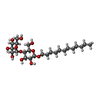


| #16: Sugar | ChemComp-LMT / #18: Sugar | |
|---|
-Non-polymers , 13 types, 278 molecules 


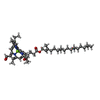




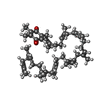














| #10: Chemical | ChemComp-CA / | ||||||||||||||||||||
|---|---|---|---|---|---|---|---|---|---|---|---|---|---|---|---|---|---|---|---|---|---|
| #11: Chemical | ChemComp-CL / | ||||||||||||||||||||
| #12: Chemical | ChemComp-CLA / #13: Chemical | ChemComp-CL7 / | #14: Chemical | #15: Chemical | ChemComp-BCR / #17: Chemical | ChemComp-F6C /  Mass: 905.457 Da / Num. of mol.: 4 / Source method: isolated from a natural source / Formula: C55H68MgN4O6 / Feature type: SUBJECT OF INVESTIGATION Mass: 905.457 Da / Num. of mol.: 4 / Source method: isolated from a natural source / Formula: C55H68MgN4O6 / Feature type: SUBJECT OF INVESTIGATION#19: Chemical | #20: Chemical | ChemComp-FE2 / | #21: Chemical | ChemComp-PL9 / | #22: Chemical | ChemComp-LHG / | #23: Chemical | ChemComp-HEM / | #24: Water | ChemComp-HOH / | |
-Details
| Has ligand of interest | Y |
|---|
-Experimental details
-Experiment
| Experiment | Method: ELECTRON MICROSCOPY |
|---|---|
| EM experiment | Aggregation state: PARTICLE / 3D reconstruction method: single particle reconstruction |
- Sample preparation
Sample preparation
| Component | Name: Monomeric photosystem II from cyanobacteria acclimated to far-red light Type: COMPLEX / Entity ID: #1-#9 / Source: NATURAL |
|---|---|
| Source (natural) | Organism:  Synechococcus sp. PCC 7335 (bacteria) Synechococcus sp. PCC 7335 (bacteria) |
| Buffer solution | pH: 6.5 |
| Specimen | Conc.: 3 mg/ml / Embedding applied: NO / Shadowing applied: NO / Staining applied: NO / Vitrification applied: YES |
| Specimen support | Details: 25 mA / Grid material: COPPER / Grid mesh size: 300 divisions/in. / Grid type: C-flat-2/1 |
| Vitrification | Instrument: FEI VITROBOT MARK IV / Cryogen name: ETHANE / Humidity: 100 % / Chamber temperature: 277.15 K |
- Electron microscopy imaging
Electron microscopy imaging
| Experimental equipment |  Model: Titan Krios / Image courtesy: FEI Company |
|---|---|
| Microscopy | Model: FEI TITAN KRIOS |
| Electron gun | Electron source:  FIELD EMISSION GUN / Accelerating voltage: 300 kV / Illumination mode: FLOOD BEAM FIELD EMISSION GUN / Accelerating voltage: 300 kV / Illumination mode: FLOOD BEAM |
| Electron lens | Mode: BRIGHT FIELD |
| Image recording | Electron dose: 40.8 e/Å2 / Film or detector model: GATAN K3 (6k x 4k) |
- Processing
Processing
| CTF correction | Type: PHASE FLIPPING AND AMPLITUDE CORRECTION |
|---|---|
| 3D reconstruction | Resolution: 2.25 Å / Resolution method: FSC 0.143 CUT-OFF / Num. of particles: 315307 / Symmetry type: POINT |
 Movie
Movie Controller
Controller



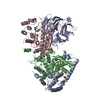

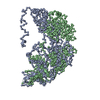



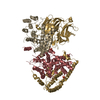

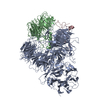
 PDBj
PDBj





















